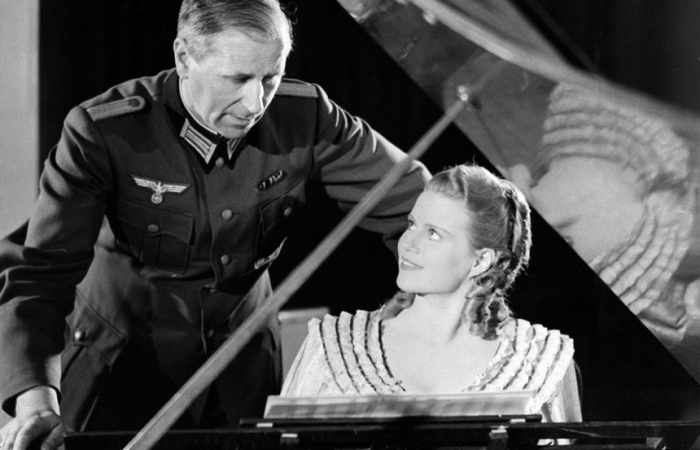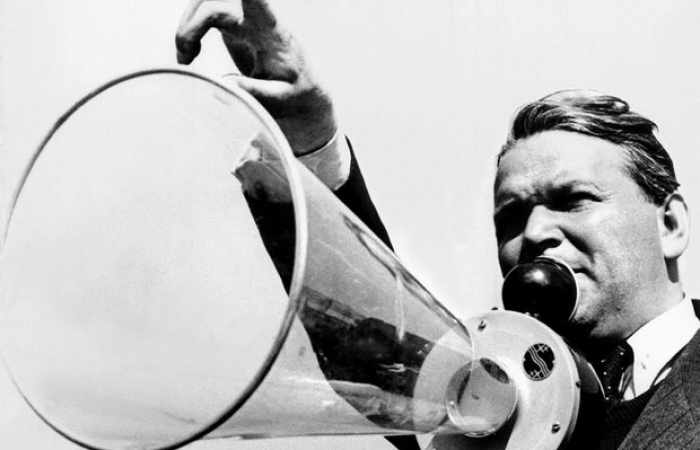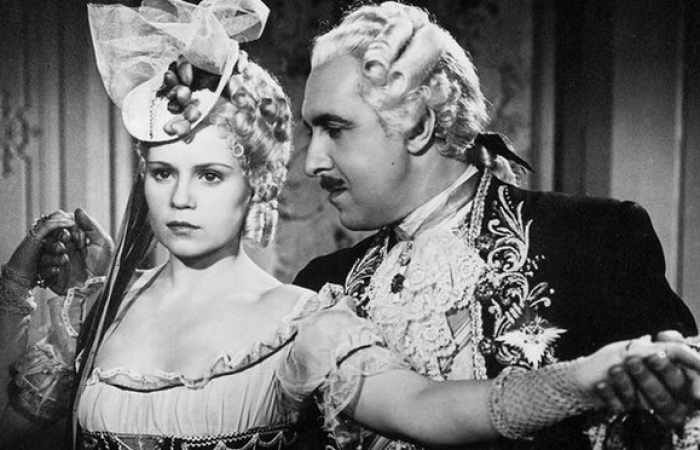We drove to Horw, near Lucerne, to interview Söderbaum, star of many films, most of them directed by her husband, Veit Harlan. These included Jud Süß, widely regarded as the most antisemitic film ever, and the ridiculous epic Kolberg, about the Napoleonic siege of the Prussian city. Söderbaum was so often drowned in her films that she became known as the Reichswasserleiche, the official State Water Corpse.
The interview took place at the house of Edie Bechter, her “protector”. Bechter conducted preparatory discussions with me. He pretended to be very sad about the treatment of the Jews and told me he wished to set up a fund to donate money to impoverished Jews in Israel. Would I help? Of course. Would I act as a sort of trustee? Of course. Given these assurances, he would facilitate the interview. Presumably, he thought I would give her an easier ride.
“Naturally,” Bechter told me, “Kristina would have hanged herself if she’d known the problems Jud Süß would bring.” Bechter had been her No 1 fan, then her best friend, and was now in a strange relationship with her. He wore her husband’s wedding ring and his house was full of Söderbaum mementoes and photos. He also owned Harlan’s death mask. Once the interview was done, Bechter evaporated and I never heard from him again.

‘I lived in a gilded cage’ … Söderbaum during rehearsals for Jud Süß. Photograph: Ullstein Bild via Getty
Söderbaum, even at the age of 80, was still very beautiful, in a traditional pink-and-white babydoll style. She had been one of the greatest stars of her era. Swedish by birth, she had big greeny-blue eyes, white curly hair and wore blue eyeliner and bright pink lipstick. A leaflet from 1942 noted: “Her acting lessons mainly consisted of refining her German pronunciation.” In a two-page questionnaire, she described herself as 100% Aryan (75% Swedish, 22% Danish, 3% Russian = 100% Aryan).
Söderbaum claimed Joseph Goebbels, head of Nazi propaganda, didn’t much like her. His taste – apart from his wife, Magda – ran to dark-haired actresses. “He told me I was not sexy but erotic,” said Söderbaum. Still, she added, “terribly many people fell in love with me. But whether that made me a sex symbol or not, I don’t know.” For her part, she found that: “Goebbels had very nice eyes but,” she added with a laugh, “he was a devil!” She said Adolf Hitler, on the other hand, was always very pleasant to her – and Harlan would often remark on his amazing eyes. She was not unimpressed by Hitler’s eyes herself.
Söderbaum could be described as the archetypical feminists’ nightmare. A beautiful woman, a very convincing actress, totally obedient and devoted to her forceful husband, she told me she had lived “in a gilded cage” and “went everywhere in a limo”. But I saw no signs of curiosity about life beyond the bars. In her autobiography, she seemed surprised by the postwar hostility towards Harlan, astonished that their children were taunted as Nazis at school in Sweden.
Goebbels was hugely powerful, she said. He could intervene in every aspect of a film. Although another director I spoke to disputed this claim, Söderbaum said Harlan had been reluctant to do Jud Süß (which translates as Süß the Jew), but Goebbels had insisted. The story starts in 1733, with the coronation of the Duke of Württemberg. The moneylender Joseph Oppenheimer Süß inveigles his way into his graces. “Clean shaven and dressed like a gentleman,” a brochure explained, “the Jew Süß Oppenheimer contrives to be appointed Finance Minister ... Süß violates the beautiful Dorothea Sturm … Jew, hands off German women!”

Indicted for crimes against humanity … director Veit Harlan in 1944. Photograph: Alamy
Söderbaum was the obvious choice for Dorothea. As she said: “They wanted me, this blonde, not very intelligent, nice, Aryan girl.” At least she was aware of her image – a sort of infantilised and fluffy pretty girl, either at the mercy of a rapacious man, or needing guidance from a strong masculine hand. She said Jud Süß was not an antisemitic film: on the contrary, everyone felt sympathetic towards the title character. Her opinion does leave open the question of why SS chief Heinrich Himmler would order the film to be shown to all SS units and to concentration camp guards, on the grounds that it would put them in the right frame of mind for their work.
By 1943, some 20 million people throughout Europe had seen Jud Süß. When I asked Söderbaum why she went along with it, she said she had no choice. I asked why she had not pretended to have a sore throat like Marianne Hoppe, another actress we had interviewed. “I was ill,” she said. “I had just given birth and was breastfeeding.” In her autobiography, she said she had claimed to be ill, but Goebbels pointed out that she had already made herself available for other roles. And doing it badly wasn’t an option “because Veit wanted to do everything well”.
Asked about the rape scene, she said: “When one looks at it today, it looks very different. Today we know so much more about the war. Then we didn’t know anything. Now we know it from the films we have seen, from terrible pictures of concentration camps and suchlike. Then suddenly it becomes much worse and one says, ‘For heaven’s sake, I helped with this!’ When one acted in it – or even was forced to act in it – we didn’t think like that. We didn’t know what it would be used for.”
Although ignorance is a poor defence, it is hard to give any similar benefit of the doubt to her husband. Harlan was accused of crimes against humanity for directing an inflammatory film that slandered Jewry and therefore provoked pogroms. He was acquitted, however, as it could not be proved that his film led directly to the deaths of any Jews. As for Söderbaum, in her autobiography she wrote that Jud Süß “burnt a wound in my soul, and whenever it seems nearly healed over, it is ripped open once more. I know it will never heal. That is my fate, I must live with it.”
After Dorothea’s rape, in accordance with Söderbaum’s customary fate, she drowns herself while Süß, gibbering for mercy, is punished with a public execution. Söderbaum later bemoaned her plight: always having to play “despondent women who ended up invariably in the sea or the swamp”, instead of being allowed to star in a jolly comedy.
In Die Goldene Stadt (The Golden City), things did seem to have ended happily for her. The film tells the story of Anna, a country girl who runs off to the city, falls in with a bad crowd, but is eventually reunited with the land, her family and her lover. But Goebbels was unhappy: the triumph of blood and soil had to be total, and sleeping around with nasty Slavs in the decadent city could lead only to tragedy. So, unbeknown to Söderbaum, he changed the final scenes. Anna, he decided, had to kill herself. A dummy was duly thrown into a marsh and Söderbaum became the State Water Corpse once more, as Goebbels wrote of being moved by the “erotics of death”.
Söderbaum recalled that when they were in Venice to receive a prize for the film (she won the Volpi Cup for best actress), she had to film a scene in which she jumped naked from a gondola. Goebbels dared her, saying she wouldn’t do it. So she took off her dress and jumped. It caused a huge scandal, though she insisted to me that she had kept her petticoat on.
Söderbaum thought Jud Süß and Kolberg were “man’s films” and said she much preferred “typical” films such as Opfergang (The Great Sacrifice) and Die Reise Nach Tilsit (The Journey to Tilsit). Modern film historians agree, one calling Kolberg “a film by men, about men, and about war and the doctrines of war. Women just do not matter.”
Söderbaum preferred more romantic fare. Her favourite scene of all was in Opfergang, in the stable, where she tells someone else’s husband: “We’re in love and that’s bad news.” It was in this film that she galloped bareback along a beach in her underwear, representing unbridled sexuality and luring her lover from his marital duty, albeit temporarily.
As for Kolberg, she said its cast were delighted to take part, because it meant they didn’t have to go to the front. She was less keen, recalling that she had to pump a lot of water during the filming, which she found a bore. She remembered, too, that the soldiers wore bandeaux made of toilet paper, such were the shortages. “I found it ridiculous to be filming when the enemy was coming nearer and nearer. One knew about the war and everything that was happening. Then, to stand in front of the camera, I felt like an idiot.”
On 19 March 1945, the real town of Kolberg – which in the film had held strong against the French – fell to the Allies. “We could do without this,” wrote Goebbels in his diary. Six weeks later, he and Hitler were dead.
This is an edited extract from The Black Page: Interviews With Nazi Film-Makers by Karen Liebreich for the Guardian.
More about: #Nazi















































